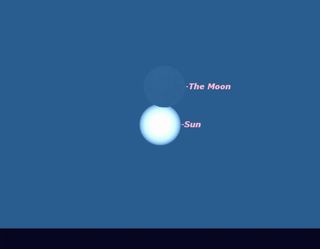'Stealth' Solar Eclipse Spotted in Satellite Photos

The moon blocked part of the sun in a partial solar eclipse today (July 1) in an event caught on camera by a European satellite, even though it was largely invisible to everyone on planet Earth.

The solar eclipse peaked at about 4:40 a.m. EDT (0840 GMT), but it was only visible from an extremely remote — and uninhabited — patch of the southern Atlantic Ocean just off the coast of Antarctica, south of Africa. NASA classified the stealthy eclipse as the "eclipse that nobody sees," but the European Space Agency's Proba-2 satellite orbiting Earth managed to observe the event using a telescope called Swap.
The Proba-2 photos show the sun with a small, dark bite missing at the point where the moon blocked the star's light. The solar eclipse lasted about 90 minutes, with the moon blocking only about 9.7 percent of the sun's surface at the event's peak. [Proba-2 satellite's July 1 solar eclipse photos]
Proba-2's Swap telescope snapped views of the eclipse in the extreme-ultraviolet range of the light spectrum and managed to perform multiple observation passes as it orbited the Earth, mission scientists said.
"SWAP observes the solar eclipse in two subsequent orbits of Proba-2," scientists wrote on the satellite mission's website.
ESA's Proba-2 satellite has a dual mission to study the sun and test new spacecraft technologies. It carries two sun-watching instruments, two space weather monitors and 17 technology demonstration experiments.

Solar eclipses occur when the moon is in its new phase and at a point in its orbit that is between the Earth and the sun. When the moon aligns perfectly with the sun, as viewed from Earth, a total solar eclipse occurs, while at other times the sun is only partly obscured.
Get the Space.com Newsletter
Breaking space news, the latest updates on rocket launches, skywatching events and more!
Friday's partial solar eclipse marked the third in a rare series of sun and moon eclipses within a one-month period and also kicked off a new cycle of eclipse events, which astronomers call Saros cycle 156.
The event followed a spectacular June 1 partial solar eclipse, which was visible over the northern polar regions of Europe and Asia, as well as the total lunar eclipse of June 15 that was observed by skywatchers across the Eastern Hemisphere.
The next eclipse of 2011 will also be a partial solar eclipse and will occur on Nov. 25. That event will be visible from southern South Africa, Antarctica, and New Zealand.
A Dec. 10 total lunar eclipse, which should be visible from eastern Asia, Australia, and northwestern North America, will round out the 2011 sun and moon eclipse events.
You can follow SPACE.com Managing Editor Tariq Malik on Twitter @tariqjmalik. Follow SPACE.com for the latest in space science and exploration news on Twitter @Spacedotcom and on Facebook.
Join our Space Forums to keep talking space on the latest missions, night sky and more! And if you have a news tip, correction or comment, let us know at: community@space.com.

Tariq is the Editor-in-Chief of Space.com and joined the team in 2001, first as an intern and staff writer, and later as an editor. He covers human spaceflight, exploration and space science, as well as skywatching and entertainment. He became Space.com's Managing Editor in 2009 and Editor-in-Chief in 2019. Before joining Space.com, Tariq was a staff reporter for The Los Angeles Times covering education and city beats in La Habra, Fullerton and Huntington Beach. In October 2022, Tariq received the Harry Kolcum Award for excellence in space reporting from the National Space Club Florida Committee. He is also an Eagle Scout (yes, he has the Space Exploration merit badge) and went to Space Camp four times as a kid and a fifth time as an adult. He has journalism degrees from the University of Southern California and New York University. You can find Tariq at Space.com and as the co-host to the This Week In Space podcast with space historian Rod Pyle on the TWiT network. To see his latest project, you can follow Tariq on Twitter @tariqjmalik.
